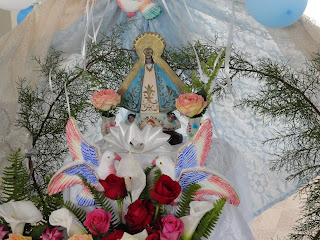Accompanying the work of Caritas includes occasionally going out to see the work in the fields. On Tuesday, February 28, I went out with Manuel López, who works with farmers in several places in the diocese.
We was bringing three young women who are doing an internship in Caritas as part of their university business administration studies. They were going to give a short workshop on administration and accounting to one of the groups with which Manuel works.
We were going to the village of San Antonio de la Montaña, up the mountain from Erandique, in the department of Lempira.
The trip took more almost four hours from Santa Rosa (including stopping for breakfast.) The worst part was going up the hill on a narrow road which was pure dust – in some places more than an inch deep. Also, some of the retaining walls had been washed out with last year’s rains. Fortunately, there was a group working on the road.
 |
| A view from near Juan's house. |
The village was on the side of the hill, with a brisk wind and an awesome view. The little church was just off the soccer field, across from the school.
As usual, the people were quite friendly, though some of the kids were a bit bashful. When I asked, one claimed that I was the first gringo they had seen there! Who knows?
The farmers involved in the project, which included women and some young people, are involved in a cooperative and thus are already fairly well organized.
It is a delight to encounter communities where the people are organized.
 |
| Some participants inside the church. Manuel is on the center, baseball cap and green shirt. |
But what really delighted me was their spirit.
One leader talked about how they had to dig up and then rebury the village’s water pipes because of the road work. Some had thought they wouldn’t be able to do it in ten days, but they accomplished the task without breaking even a single of the 4 inch pipes. This was in marked contrast with other communities, some of whom just let some of their pipes be destroyed.
The workshop went well, though I think many of the 18 present already knew a fair amount about administration of a small business and a few knew something about accounting.
During lunch Juan took Manuel and me to see his fields where there is already some irrigation. It appears that a group gave them material years ago but did no follow-up work with them. Juan seems to be doing a fairly good job with his field.
 |
| Juan's tomato crop. |
Manuel will work with the group to help them improve their farming techniques.
 |
| Some participants outside the small church. |
Hopefully the famers will be able to produce enough to sell. Two challenges are the road and where three might be markets. They are hoping that the mayor will open a stall for them in the town market. The road is being repaired but whether it will be good enough to allow access during the rainy season is another question.
All in all, it was a good place to visit, seeing some successes amid all the challenges that Honduras faces.
 |
| Waterfall below the water source for the village. |
Tomorrow, Thursday, March 1, I’ll be facilitating a day and a half workshop on Catholic Social Teaching for folks in the diocese, largely those involved in the schools for democracy and participation. Interestingly, Juan and Hipólito from San Antonio are supposed to come.


































